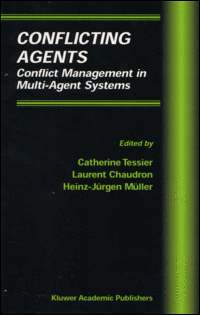Reviewed by
James A. R.
Marshall
Complex
Systems Modelling Group, Department of Earth Science and
Engineering, Imperial College, London.

Conflicting Agents presents a collection of papers on the central theme of conflict management in multi-agent systems (MAS). According to the publisher "this book addresses questions about types of conflicts, conflict definitions and the use of conflicts as trigger functions for activities in [MAS]. The book is also dedicated to questions of conflict management, resolution and avoidance..." As one might suppose, this subject matter is large and diverse, and it is most likely for this reason that the book seems to lack a certain level of cohesion.
Conflicting Agents begins with an introductory chapter by the editors in which they discuss such fundamental issues as agent definitions, classification of modes of study, and characterisations of conflicts (both abstract and human, and within MAS). They go on to propose a unified definition of conflict based on propositional attitudes, and consider conflict handling among humans and agents and in particular the status of conflict with regard to MAS. The remainder of the book is divided into three sections of three chapters each, the subjects of these sections being "Conflicts and Agents: Essentials", "Conflicts of Operational Agents" and "Application Centred Agents' Conflicts".
The first of these sections, on the essentials of conflicts and agents, begins with a chapter by Castelfranchi and Falcone on conflicts that occur during collaboration between agents that are predisposed to collaborate, where conflict is confined to conflict over the nature of the collaborative relationship. Of particular interest in this chapter is the analysis of the significance of functional violation of norms (FVN) during collaboration within organisations. FVN involves systematically ignoring "official" working practices in order to collaborate more efficiently. In the next chapter, Hannebauer examines the transition between conflicts occurring within an agent and conflicts occurring between several external agents. Hannebauer's approach is to model such conflict situations as constraint satisfaction problems and he presents his own modular architecture for solving them. In the concluding chapter of the section Malsch presents an interesting attempt to link sociology and distributed artificial intelligence but provides little in the way of concrete examples for the usefulness of this approach. The next section on conflicts in operational agents starts with Jung and Tambe's chapter on conflict resolution through argumentation in which they present their argumentation-based negotiation system and examples of its application. This is followed by Penders' chapter in which he describes conflicts arising in a simple domain (navigation in a two-dimensional world) and the resulting team-level behaviours. This section concludes with a chapter by Chantemargue in which a somewhat unusual view on emergence in MAS is discussed, followed by the presentation of a collective robotics model, apparently very similar to Hemelrijk's (1997), in which agents inadvertently collaborate to stack objects in a spatial environment into a single pile without being aware even of the existence of other agents around them.
In the final section, which deals with application centred conflicts between agents, the first chapter by Aïmeur presents an approach based on cognitive dissonance theory that gives conflicts a positive role in a tutoring system. Unfortunately, the impression left by this chapter is that of a learning psychology experiment realised using a computer rather than a study of MAS conflict in the spirit of the rest of the book. Denzinger's chapter on conflict handling in collaborative search follows, and largely takes the form of a review chapter, presenting little evidence for the claims it advances for the efficacy of certain approaches to conflict resolution. The section and the book conclude with a more philosophical chapter by Lawless et al. in which they consider the benefits of replacing conflict with co-operation in the solution of well-defined problems and ill-defined problems and conclude that conflict improves the ability to solve ill-defined problems. Of particular interest in this chapter is the discussion on the process of forming knowledge about reality, the circumstances under which such knowledge can be independent of reality, and under which convergence in such knowledge can fail to occur resulting in multiple (but stable) coexisting views of reality.
As already noted Conflicting Agents, despite its unifying theme of conflict management in MAS, seems to be a book lacking in cohesion. Only the first, last and penultimate chapters make inroads into providing such cohesion by referring to other chapters in the book, with the remaining seven chapters each seeming more or less independent of each other. However perhaps one unifying and interesting theme can be identified in a general tendency for the chapters in this book to treat conflict not necessarily as a destructive force, but rather something that drives evolution and innovation in MAS.
Furthermore there are some interesting gems to be plucked from this book if one has the patience or luck to find them. One nice example is Castelfranchi and Falcone's assessment of the potentially damaging impact of formalising work procedures through the introduction of information technology, due to the aforementioned importance of FVN within organisations.
In conclusion despite criticisms about lack of cohesion, to which can be added the observation that improved copy editing would have helped the exposition of the book in several instances, Conflicting Agents represents a useful reference work on some of the latest approaches to conflict in MAS, in which most working in the field will be likely to find much of interest.
HEMELRIJK C. K. 1997. Co-operation without genes, games or cognition. In P. Husbands and I. Harvey, editors, Fourth European Conference on Artificial Life. The M. I. T. Press, Cambridge, MA.
Return to Contents
of this issue
© Copyright Journal of Artificial Societies and Social Simulation, 2003